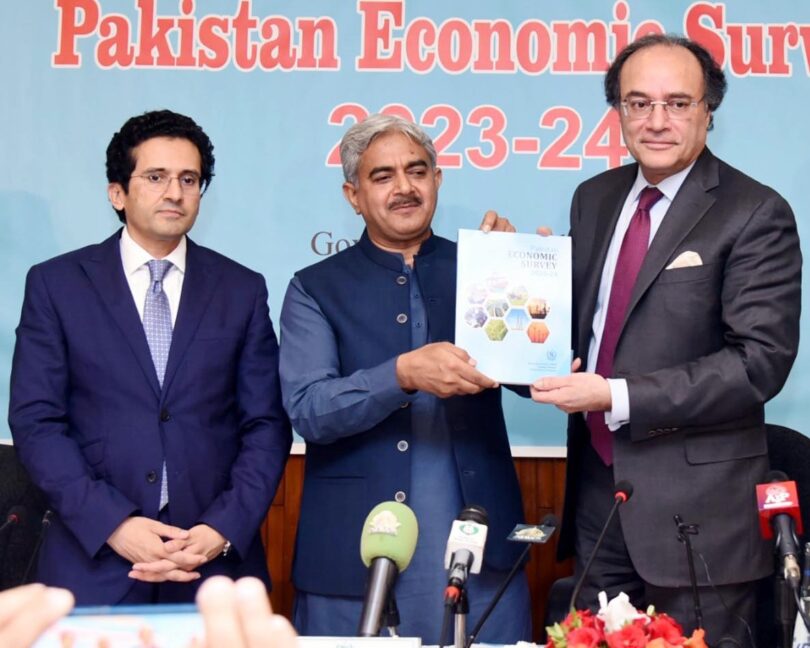F.P. Report
ISLAMABAD: Finance Minister Muhammad Aurangzeb has unveiled the Economic Survey of Pakistan 2023-24 as part of an yearly exercise before the presentation of budget. The Pakistan Economic Survey is an annual report that charts the country’s economic progress for the outgoing financial year. For the next fiscal year, the National Economic Council (NEC) approved a massive increase in its Public Sector Development Programme (PSDP) share.
Addressing a press conference in Islamabad, Finance Minister Muhammad Aurangzeb announced that revenue collection for the fiscal year 2023-24 saw a 13 percent rise compared to the previous year. “Pakistan rupee depreciated by 29pc and the foreign exchange reserves went down to two weeks of import cover in fiscal year 2022-23 that is where we started off,” said the finance minister at the start of his presser. The finance minister said the country started off its journey to launch reforms under the leadership of PM Shehbaz.
He said the coalition government, upon assuming office last year, had to seek an emergency bailout package from the International Monetary Fund (IMF). “This IMF assistance is the reason why we are now able to discuss our economic targets,” he remarked. “I was in the private sector before joining the finance ministry but at that time I was clear that Pakistan had to go to IMF because we did not have any option and that’s why its called lender of the last resort, “he remarked.
“If we had not been in the IMF programme, we would not have been discussing the targets here and would have been in a precarious situation,” the minister highlighted. “The larger-scale manufacturing growth was affected due to the effects of the energy equation,” he said, adding that agriculture was the “saviour” backed by the bumper crops.
“Agriculture is going to remain a huge lever of growth as we go forward,” he said. The growth rate of agriculture was 6.25 percent. The quarterly growth rates have been observed at 8.6 percent, 5.8 percent, and 3.9 percent in Q1, Q2, and Q3 of FY 2024, respectively.
The sector’s recovery is attributed to government initiatives, improved input supply, and increased credit disbursement to farmers. Important crops like cotton, rice, and wheat observed healthy growth, while sugarcane and maize experienced negative growth.
However, the negative impact of sugarcane and maize was offset by the high growth of wheat, cotton, and rice. Livestock, a significant portion of the agriculture sector, showed resilience and maintained average growth. The Federal Board of Revenue (FBR) tax collection grew by 30.6pc to Rs7,361.9 billion from July to April. The collection target for the 12-month period set by the government was Rs9,415bn.
The collection was Rs5,637.9 billion in the year-ago period. He emphasised that while philanthropy can support schools, universities, and hospitals, the country’s functioning relies on taxes. “That’s one certain[ty]. That’s the basic principle,” he said.
Aurangzeb stressed the need to increase the tax-to-GDP ratio and implement complex energy and power sector reforms. Total public debt was recorded at Rs 67,525 billion at end-March 2024. Domestic debt was recorded at Rs 43,432 billion while external public debt was recorded at Rs 24,093 billion (US $ 86.7 billion). Public debt portfolio witnessed various positive developments during first nine months of outgoing fiscal year. On inflation, he noted that it had peaked at 48pc and had since decreased to 11.8pc in May.
He highlighted the significance of core inflation and food inflation also coming down. The CPI inflation for the period July-April FY 2024 recorded at 26 percent as against 28.2 percent during the same period last year. The other inflationary indicators like Sensitive Price Indicator (SPI) recorded at 30.2 percent as against 31.7 percent last year. Wholesale Price Index (WPI) recorded at 22.4 percent in July-April FY 2024 compared to 34 percent same period last year.
He highlighted that the GDP growth rate was 2.38%, falling short of the target due to ongoing economic challenges. The survey said the government is implementing a comprehensive set of administrative, policy, and relief measures to address inflation and proactively help the vulnerable members of society. The economic survey also indicated that the rupee depreciated by 29% during the fiscal year.
The finance minister highlighted that the currency had witnessed stability due to, he mentioned, the policies of the caretaker government. The finance minister said the large scale manufacturing sector faced significant setbacks due to inflation, increased energy costs, and other issues.







